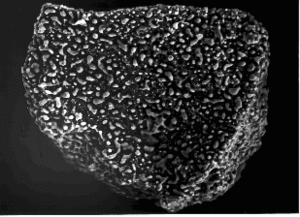Ilmenite Reduction
| This article is incomplete or needs more information. You can help Lunarpedia by expanding or correcting it. |
Reduction of ilmenite (FeTiO3) refers to a variety of chemical reactions proposed for use in the production of oxygen
(LUNOX) from lunar resources. The term "reduction" refers to a change in the oxidation state of an atom, molecule, or ion in which an electron is gained. This is the opposite of an oxidation reaction in which an electron is lost.
Hydrogen Reduction
Hydrogen reduction is one method currently being tested by many Universities. Products of hydrogen reduction are free iron, titanium dioxide (TiO2), and water, which is split to recover the hydrogen and produce oxygen.
The basic process is to separate ilmenite from lunar soil, crush it to a fine powder to maximize the surface area, and then heat it in an enclosed reaction vessel in the presence of hydrogen gas. The steam produced in the reaction is then condensed and split to produce oxygen and recover the hydrogen.
The iron produced in the process can be separated out by carbonyl extraction, or by grinding the result again and using a magnet.
This process is best utilized if the plant is sited in a location in which ilmenite composes a high fraction of the soil.
The reaction sequence is:
- Reduction: FeTiO3+H2 ---->Fe+TiO2+H2O
- Water Splitting: 2H2O ---->2 H2+ O2
- Net Reaction: 2FeTiO3----> 2Fe+2TiO2+ O2
Carbothermal Reduction
Oxygen can be retrieved from Ilmenite (FeTiO3) and Rutile (TiO2) by means of carbothermal reduction. In experiments, powdered carbon and powdered ilmenite/rutile were evenly mixed and then heated to 1500 degrees Celsius. The end products of this reaction are Oxygen and a high strength Ceramic-metal composite (Cermet) of Iron (Fe) and Titanium Carbide (TiC) which has high chemical stability. The amount of reinforcing TiC ceramic in the matrix can be controlled via the amount of rutile and carbon used. While this method provides a means of retrieving all of the oxygen from ilmenite/rutile and a potential for producing reinforced, high performance and wear components and cutting tools from lunar regolith, it is at the cost of highly valuable carbon needed for biological processes. The process will also require the separation of ilmenite/rutile from regolith by some means.
Stoichiometry for this reaction:
Ilmenite:
FeTiO3 + 4C ---->Fe + TiC + 3CO
Ilmenite and Rutile:
FeTiO3 + nTiO2 + (4+3n)C ---->Fe + (1+n)TiC + (3+2n)CO
Where n represents the number of TiO2 molecules
Reduction with CO
This reaction is based on a fluidized bed scheme which is similar to large scale proposals for Hydrogen Reduction. The product of CO reduction of Ilmenite is Carbon Dioxide (CO2), which must be cracked using significant energy in an endothermic electrolysis reaction to yield oxygen which can be drawn off via a ceramic membrane. See this paper, page 9. The presence of solar wind implanted carbon in the regolith (20-30ppm) will allow the recovery of additional carbon, but the presence of solar wind implanted hydrogen (hundreds of ppm) may complicate the reaction into one that involves methane (CH4). The CO reduction of ilmenite is slower than the H2 process, but by less than an order of magnitude for any given temperature.
The reaction sequence is:
Reduction:
FeTiO3 + CO ---->Fe + TiO2 + CO2
Endothermic cracking:
2CO2 ----> 2CO + O2
Net Reaction:
2FeTiO3 + 2CO ---->2Fe + 2TiO2 + 2CO + O2
Methane Reduction
| Please note: Methane Reduction This section is a placeholder for work currently in progress. |
Li or Na Reduction
Plasma Reduction
Electrolytic Reduction
External Links
- ISRU on the Moon. by Larry Taylor http://www.lpi.usra.edu/lunar_knowledge/LTaylor.pdf
- Extraction Techniques-Oxygen. G. L. Kulcinski, February 18, 2004 http://fti.neep.wisc.edu/neep533/SPRING2004/lecture13.pdf
- Processing Lunar Soils for Oxygen and Other Materials. Knudsen & Gibson http://nss.org/settlement/nasa/spaceresvol3/plsoom1.htm
- Lunar Oxygen Production - A Maturing Technology
- The Effect of TiO2 on Synthesizing Fe-TiC Composites
- Resources of Near-Earth Space. Univ. of Arizona Press







